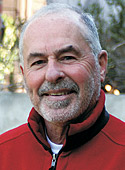Lawrence Badash
DOI: 10.1063/1.3580500
Lawrence Badash, professor emeritus at the University of California, Santa Barbara (UCSB) and renowned historian of physics, passed away on 23 August 2010 in Santa Barbara after a brief fight with pancreatic cancer. A one-time chair of the American Physical Society’s history of physics division (now forum), Larry is best known for his meticulous research and lucid writings on the history of nuclear physics and nuclear weapons; his influential publications covered topics ranging from Ernest Rutherford to Los Alamos to the nuclear-winter controversy.
Born on 8 May 1934 in Brooklyn, New York, Larry studied physics, and played lacrosse, at Rensselaer Polytechnic Institute as a Reserve Officers’ Training Corps student. After serving three years as a naval aviator following graduation, he returned to the study of physics at Yale University but was soon drawn to the new field of the history of science. He became the first doctoral student of Derek de Solla Price, a historian of science and a founder of scientometrics, often called the science of science.
Larry completed his PhD in 1964 with a dissertation that later appeared as the well-received monograph Radioactivity in America: Growth and Decay of a Science (Johns Hopkins University Press, 1979). Even though the book primarily covers developments in the US, the research started Larry’s lifelong interest in the life and science of Rutherford as a pioneer of radioactivity and nuclear physics. It led to his editing two valuable reference works, Rutherford and Boltwood: Letters on Radioactivity (Yale University Press, 1969) and Rutherford Correspondence Catalog (American Institute of Physics, 1974), and to writing Kapitza, Rutherford, and the Kremlin (Yale University Press, 1985), which recounted how Rutherford tried to support his Russian physicist protégé Peter Kapitza after the latter was detained in the Soviet Union in the 1930s. In a guest editorial for Science in 1971 marking the centennial of Rutherford’s birth, Larry remarked that though his subject “was no mathematical physicist, there is a notable theoretical component” to each of his major discoveries.
Larry arrived at UCSB in 1966; he taught the history of physical sciences there until his retirement in 2002. His course The Atomic Age, which innovatively integrated the social, political, and scientific histories of nuclear physics and nuclear weapons, proved popular from the beginning. In that class generations of students were introduced to the doomsday clock, from the Bulletin of the Atomic Scientists, as it steadily approached the midnight of nuclear disaster. From the lectures came his book Scientists and the Development of Nuclear Weapons: From Fission to the Limited Test Ban Treaty, 1939–1963 (Humanities Press, 1995), now a standard course text.
In 1975 Larry organized a popular series of lectures by scientists from the Manhattan Project. Those lectures were later collected in Reminiscences of Los Alamos, 1943–1945 (Reidel, 1980), which Larry edited with Herbert Broida and Joseph Hirschfelder. The book features Richard Feynman’s now famous account “Los Alamos from Below” and the perspectives of Laura Fermi and other women who worked on the project.
Larry’s work on the history of nuclear weapons reinforced his interest in science and social responsibility, which led him to devote increasing attention to the social, political, and moral issues related to modern physics. His last book, A Nuclear Winter’s Tale: Science and Politics in the 1980s (MIT Press, 2009), examines the debates over what would happen to Earth in the event of a thermonuclear war. Based on interviews with prominent nuclear-winter scientists and on careful studies of government documents and media reports, the book elucidates the gradual realization of what Badash called the “suicidal nature of nuclear war” and the emergence of climate change as a global scientific issue. At the time of his death, he was completing a study of science and McCarthyism he titled “Science in the Haunted Fifties.”
A kind and generous man with a warm personality, a quirky sense of humor, and a strong sense of social justice, Larry devoted himself not only to his teaching and scholarship but also to the welfare of his community, from the local to the international. He was a caring mentor who fostered equal and open relationships with his graduate students. An avid hiker, he often led what he playfully called “death marches” in the back country of Santa Barbara, and for many years he was on the local search and rescue team. He viewed his popular writings, such as PHYSICS TODAY articles on the discovery of radioactivity (February 1996, page 21) and Marie Curie (July 2003, page 37), as a public service. He promoted international educational and scholarly exchanges and lectured in many countries on the history of science and nuclear policy; when visiting Nepal, he loved to trek in the Himalayas. He exercised his social conscience by joining protests against the Vietnam War, by opposing what he regarded as dangerously aggressive US nuclear weapons policy (and UC management of the weapons laboratories), and by serving as president of the Santa Barbara chapter of the American Civil Liberties Union.
Larry Badash distinguished himself as a leader in the history of physical sciences. His books, papers, and teaching consistently joined two cultures by exploring the intricacies of physics while also explaining the immense impact of science on society.

Lawrence Badash
NANCY HOFBAUER

More about the Authors
Zuoyue Wang. California State Polytechnic University Pomona.
Peter Neushul. University of California, Santa Barbara.




